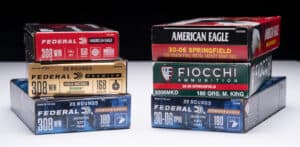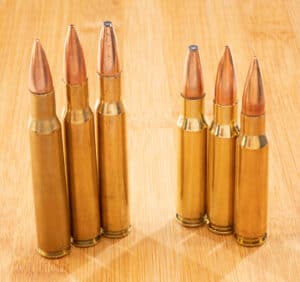Born Fighting: 30-06 vs 308
Innovation is not limited to just one era. The foundation for today’s guns was built in the early 1900’s, when changes in manufacturing and the needs of combat brought forth guns that were revolutionary for their day, which led in turn to changes in what ammunition was in common use. Today, we’re going to compare two common rifle rounds and look at .30-06 vs. .308. One was a product of the beginning of this revolutionary period in firearms design, and the other, in many ways, was the culmination of that era.
30-06 vs 308 Fast Facts
- 30-06 served as the standard rifle cartridge of the U.S. military for fifty years
- New rifle and ammunition designs during WWII drove demand for a new military round
- .308 is also known as 7.62x51mm NATO and is still in service today
The 30-06 round traces its origins back to the late 1800’s, when the introduction of more powerful smokeless gunpowder compounds meant that rifle rounds could be more powerful than ever before. This in turn created a demand for rifles that could shoot those cartridges without catastrophic failure. The bolt-action Mauser rifle soon emerged as the preferred action to use with these new rounds.
The 30-06 vs 308 Debate Began On The Battlefield
The American army went in a slightly different direction, though. In 1892 it adopted the Springfield Model 1892–99 (aka the Krag–Jørgensen rifle), chambered in 30-40 Krag, as the standard service rifle. The Model 1892-99 was slower to load and less accurate at longer ranges than the Mauser. These drawbacks became very apparent during the Spanish-American War, when American troops came up against soldiers in Cuba armed with Mauser rifles.
The edge that the Mauser rifle had over the M1892-99 forced the government to do a quick U-turn, and soon they created the M1903 Springfield rifle, based on the Mauser action. The M1903 was initially developed to use the .30-03 cartridge, which had a bullet with a rounded nose. Testing showed that a spitzer, or pointed nose, bullet had better accuracy and long-range performance. Thus, the .30-06 cartridge was born in (you guessed it) 1906.
The 30-06 round proved to be extremely popular and quickly moved beyond bolt-action rifles. The M1919 machine gun shoots .30-06, as does the M1918 Browning Automatic Rifle. For many Americans, though, the ultimate expression of the 30–06 round was the M1 Garand semi-automatic rifle, which served America well in World War II.
Changing Times, Changing Requirements
However, World War II soon revealed that in most cases, a smaller gun which fired a lower-powered round than .30-06 was a better fit for the average infantryman. This led to guns such as the M1 Carbine, MP44 Sturmgewher and the AK-47. All of these guns were lighter than contemporary full-size guns but were still effective out to at least 200 yards. America, along with the other NATO countries began to look for a replacement for their full-sized rifles. And with that decision, the first .30-06 vs 308 competition was born.
Except it didn’t begin with 30-06 vs 308, it began with 30-06 going up against the smaller .280 British cartridge. 280 British was a smaller diameter (7mm), lower-powered cartridge with ballistics that were similar to the 7.62x39mm round used by the Russians in the AK-47 or the 7.92mm Kurz round used in the Stg44. The United States military, however, had 50 years of success with the 30-06 round and was hesitant to switch to a smaller, less powerful round. A compromise (of sorts) was reached in the form of the 308 round, which was introduced and standardized as the 7.62x51mm NATO round.
.308 Takes The Lead
7.62x51mm NATO has since been replaced in most front-line NATO rifles by the 5.56mm NATO round. However, it is still very much in use by the military in longer-ranged rifles and machine guns. 308/7.62x51mm is also a popular round for armed citizens for applications such as self defense, competition and hunting. .30-06 is also extensively used by armed citizens, primarily for competition and hunting. Both are excellent rounds and have been used by the military for decades. The primary differences between .30-06 and .308 show up in what guns they are used in and in the outer edges of the performance envelope for both rounds.
.30-06 is a longer cartridge than .308. This means that it will not fit in any standard AR-pattern gun, the most popular style of gun in America, and requires so-called “long-action” bolt-action rifles. 308, on the other hand, uses a short-action gun. Shorter actions means shorter, lighter rifles, so bolt action rifles tend to be heavier and more cumbersome if they are chambered in .30-06 vs 308.
Comparing The Ballistics of 30-06 vs 308
When it comes to ballistics, there are some slight differences between 30-06 versus 308. Both rounds use bullets that are approximately in the same weight range (147 grains or so on up to 180 grains) with similar velocities. The accuracy of the two cartridges is very similar out to 600 yards or so, with .30-06 having a little more power at longer distances than 308.
The choices of available ammo styles in .30-06 vs 308 give us hints as to the role that each gun has in American gun culture. 30-06 ammo has a wide selection of cartridges designed for hunting, as well as some match-quality ammo and FMJ rounds for target practice. 308 ammo, however, runs the gamut from self-defense rounds to match ammo to hunting rounds to FMJ practice ammo, hinting that it has a following that is into more activities than just hunting and target shooting.
Die-hard supporters of the M1 Garand will continue to sing the praises of the .30-06 round, and fans of the M1A/M14 rifles, their only slightly less fervent cousins, will talk about how 308 is the only “real” service rifle round left in common use. However, both rounds are accurate at most common engagement ranges, and both deliver enough punch to deal with just about any four-legged game in North America. Both can also serve as protection against humans who would prey on other humans.
It’s What You Do That Matters Most
The biggest question in the .30-06 vs 308 debate isn’t really about the calibers themselves, it’s about the guns we associate with each caliber. Both .30-06 and .308 are excellent choices for bolt-action rifles. If you like rifles from the WW1 and WWII era, such as the M1903 Springfield or the M1 Garand, you’ll probably gravitate towards .30-06. If, however, you like guns like the M1A, AR-10 or want to shoot precision rifle out to 1000 yards, .308 is going to be your caliber of choice. No matter which round you chose, your key to success is going to be found in diligent practice and consistent training, and not along the margins of one highly effective caliber or another.




